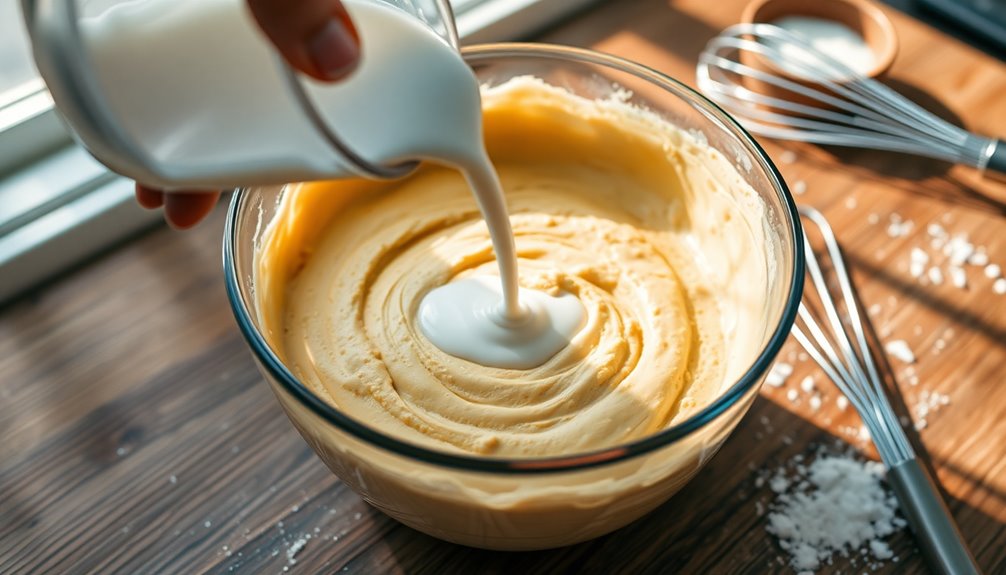Adding milk to pancake mix is a great way to enhance fluffiness and flavor. Choose a milk that suits your taste, like almond for a nutty hint or oat milk for extra creaminess. Separate your dry and wet ingredients for a smoother batter, and avoid overmixing to preserve air pockets. Allow the batter to rest for 5-15 minutes to activate leaveners and create that airy texture. Don't forget the right amount of baking powder, as it's essential for rising. Want to know more tips and tricks to elevate your pancake game? You won't want to miss what's next!
Key Takeaways
- Use a creamy milk option like oat or coconut milk to enhance the fluffiness and texture of your pancake batter.
- Separate dry and wet ingredients before mixing to prevent clumping and ensure a smooth batter for light pancakes.
- Allow the batter to rest for 5-15 minutes to activate leaveners, contributing to a fluffier pancake.
- Incorporate a leavening agent like double-acting baking powder for optimal gas bubble formation during cooking.
- Preheat your griddle to 375°F to create the ideal cooking environment for perfectly fluffy pancakes.
Choosing the Right Milk
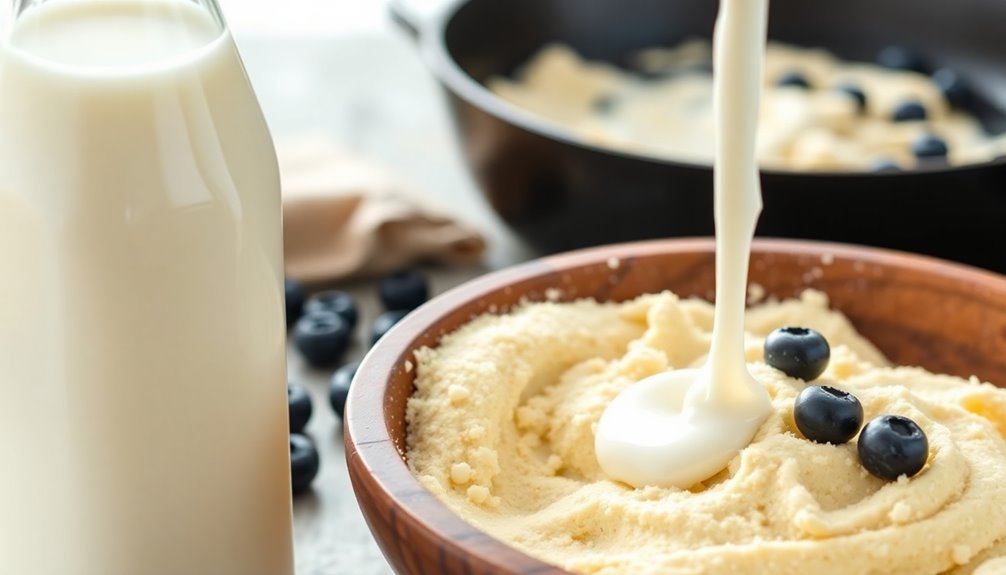
When it comes to making fluffier pancakes, choosing the right milk can make all the difference. Almond milk offers a slightly nutty flavor and is lower in calories, while oat milk's creamy texture can enhance fluffiness. If you're after a rich, tropical taste, coconut milk adds luxurious creaminess. Soy milk's neutral flavor works well in most recipes, and rice milk provides a mild option, though it may be thinner. Consider the consistency: oat milk's thickness can lead to fluffier outcomes, whereas almond and rice milks may require recipe adjustments. Additionally, nutritional values vary among substitutes, so it's essential to choose one that fits your dietary needs. Ultimately, pick a milk that complements your desired flavor and texture, ensuring your pancakes turn out deliciously fluffy every time.
Mixing Techniques
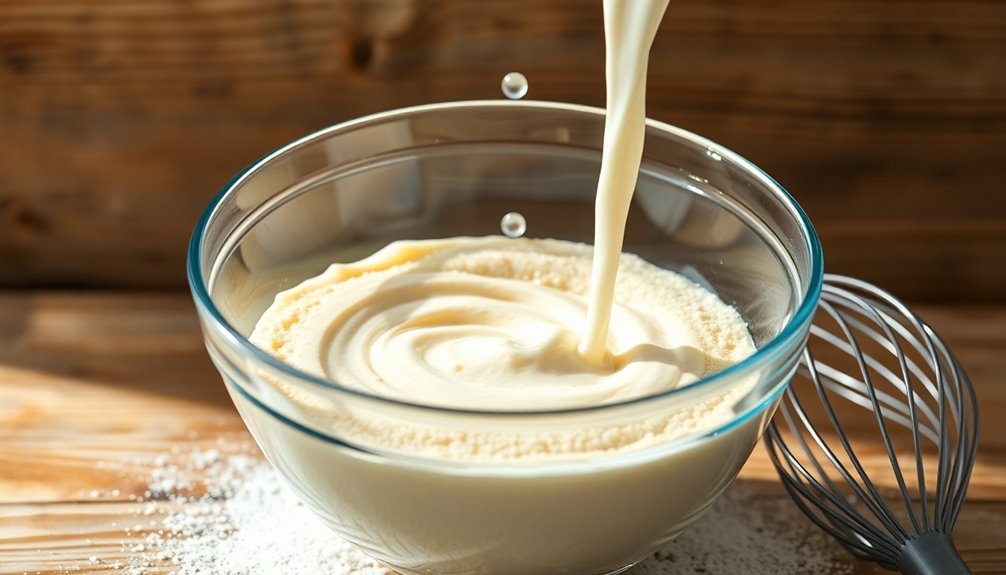
To achieve the fluffiest pancakes, mastering mixing techniques is key. Start by sifting your dry ingredients to introduce air, making the mix lighter. Then, separate wet and dry components into different bowls to guarantee even distribution and prevent clumping. Whisk your wet ingredients until bubbles form, which helps emulsify the fats and water. Remember to avoid overmixing; combine your ingredients just until they're mixed to maintain those precious air pockets. Resting the batter for 15 minutes allows the leaveners to activate for fluffier pancakes.
Here's a quick overview:
| Technique | Purpose | Result |
|---|---|---|
| Sifting | Introduces air | Lighter, fluffier mix |
| Separating | Prevents clumping | Smooth, uniform batter |
| Avoiding Overmixing | Preserves air pockets | Fluffy pancakes |
Baking Powder and Leavening Agents
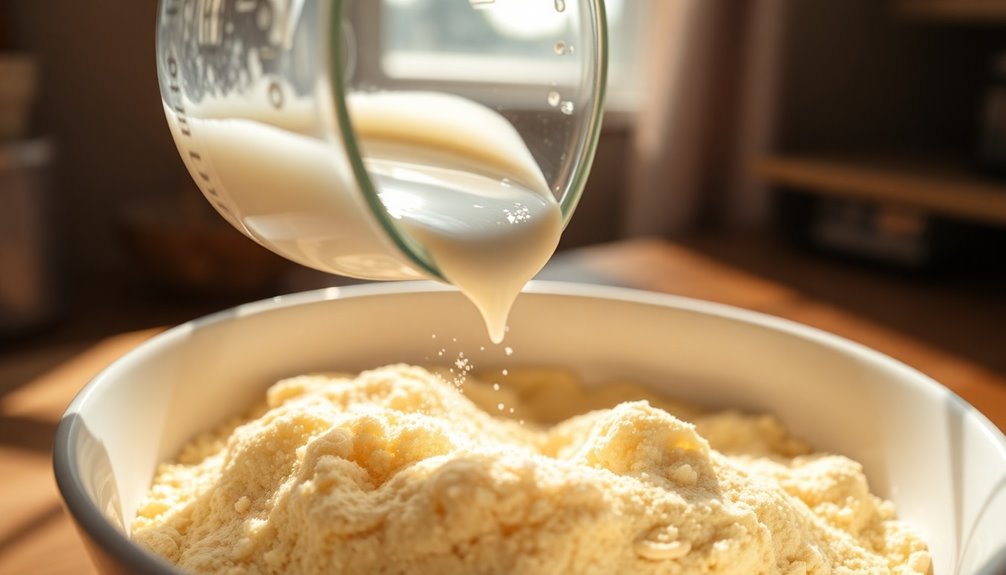
When it comes to fluffy pancakes, the type and freshness of your leavening agents matter a lot. Baking powder and other leavening agents create the bubbles that make your pancakes rise, but they can lose their effectiveness over time. Understanding how these reactions work can help you achieve that light, airy texture you crave. Additionally, using a chemical leavener like baking powder is critical for gas bubble formation, which contributes to the fluffiness of your pancakes. To ensure optimal freshness, consider checking the expiration date of your baking powder to guarantee it's still effective in producing those delightful bubbles.
Types of Leavening Agents
Two primary types of leavening agents can make your pancakes fluffier: baking soda and baking powder.
Baking soda, or sodium bicarbonate, needs an acid like vinegar or buttermilk to produce carbon dioxide (CO2). It's perfect for recipes that already include acidic ingredients, giving your pancakes a quick rise when activated. In contrast, baking powder is a combination of baking soda and a powdered acid, typically cream of tartar. It's a self-contained leavening agent, releasing CO2 when mixed with liquids. This makes it convenient and reliable, especially for recipes without added acids.
Both options can elevate your pancake game, so choose according to what you have on hand!
Freshness Importance
Although it might seem minor, the freshness of your baking powder greatly impacts the fluffiness of your pancakes. Using stale baking powder can lead to dense, flat results. To guarantee your pancakes rise beautifully, consider these tips:
- Storage Conditions: Keep baking powder in a cool, dry place, ideally below 70°F (21°C). Use airtight containers to protect it from moisture. Additionally, ensure the area around your cooking space is free from flammable objects to maintain a safe environment.
- Shelf Life: Unopened, it lasts up to 18 months, but opened containers should be used within 3 to 6 months for best results. Pancake mix can also degrade in quality after its shelf life, affecting the overall outcome of your pancakes.
- Testing Freshness: You can mix 1 teaspoon of baking powder with 1/3 cup hot water; if it bubbles vigorously, it's still active.
Baking Powder Reactions
Baking powder reactions are crucial for achieving fluffy pancakes. Fresh baking powder is just the beginning of achieving fluffy pancakes. Understanding its leavening reactions is essential. Baking powder releases carbon dioxide gas when mixed with water and heat, which makes your pancakes rise. Here's a quick overview:
| Type | Reaction Trigger | CO2 Release |
|---|---|---|
| Single-acting | When hydrated | Instant |
| Double-acting | When hydrated & heated | Two stages |
| Acidic Ingredients | Enhances reaction | Boosts fluffiness |
| Mixing Timing | Immediate use preferred | Prevents bubble loss |
| Measurement | Accurate for best results | Guarantees proper rise |
The effectiveness of baking powder and its ability to create a light texture in pancakes relies on leavening agents that produce carbon dioxide gas during cooking.
Fat Content and Texture
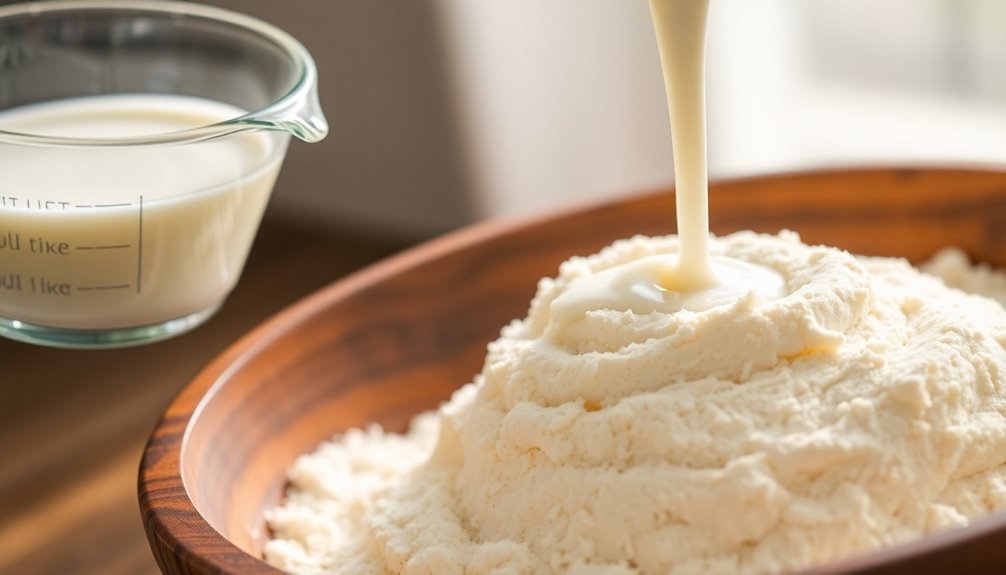
When you think about pancake texture, the fat content plays a vital role. Choosing the right fat, like milk, can make your pancakes tender and rich, while also adding essential nutrients. Additionally, incorporating milk can enhance the caloric value of your pancakes, providing a boost of energy for your breakfast.
Importance of Fat Content
Fat content plays an essential role in achieving the perfect pancake texture. When you add milk to your pancake mix, it enhances the overall consistency and lightness of your batter. Here's how:
- Batter Consistency: Milk rehydrates fats, increasing moisture and making the batter easier to handle.
- Leavening Activation: The acidity in milk activates baking soda, creating carbon dioxide bubbles that contribute to fluffiness. This occurs because liquid addition helps rehydrate fats and activates baking soda, leading to fluffiness.
- Texture Improvement: The fat helps form a flexible gluten network, resulting in a chewy yet airy pancake.
Choosing the Right Fat
Selecting the right type of fat can considerably elevate your pancake game. Buttermilk mixes, with their dehydrated fats, rehydrate beautifully, enhancing richness and flavor. Regular mixes often contain soybean oil, which helps maintain moisture but may lack depth.
If you prefer natural alternatives, look for mixes using real sweet cream buttermilk for an authentic taste. Additionally, incorporating healthy fats from nuts can provide a unique flavor and texture to your pancakes.
When you swap water for milk, you're adding more fat, resulting in tender, richer pancakes. Higher fat content generally leads to a moist texture, trapping CO2 bubbles for fluffiness. Additionally, using a just-add-water mix can simplify preparation while still offering a delicious outcome.
Just remember not to over-mix your batter; this keeps gluten from toughening your pancakes. Quality ingredients and the right liquid ratios guarantee a perfect balance, making your breakfasts irresistibly delightful.
Alternative Ingredients
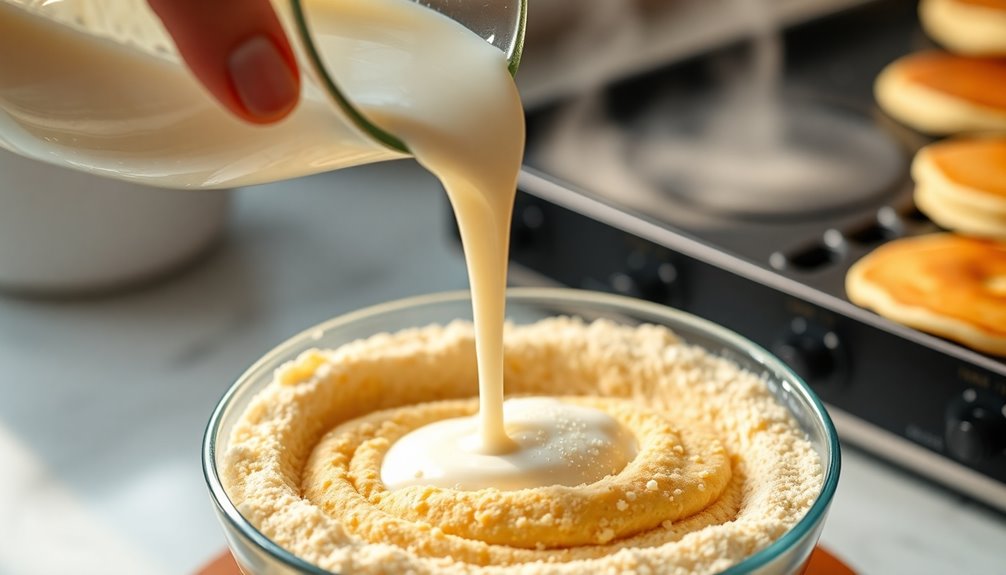
- Dairy-Free Milk Substitutions: Use soy, almond, oat, or hemp milk for a creamy base without dairy. Non-dairy milks serve as flavorful alternatives that can enhance the overall taste of your pancakes. Incorporating chia seeds into your pancake mix can also add nutritional benefits, such as omega-3 fatty acids and fiber.
- Egg-Free Substitutions: Replace eggs with applesauce, flaxseed, or mashed banana to maintain fluffiness.
- Gluten-Free Flours: Opt for coconut, almond, or rice flour to keep your pancakes light and airy. These alternatives not only accommodate dietary restrictions but also enhance your pancake experience.
Experimenting with these ingredients can lead to delicious results that everyone will enjoy!
Cooking Techniques
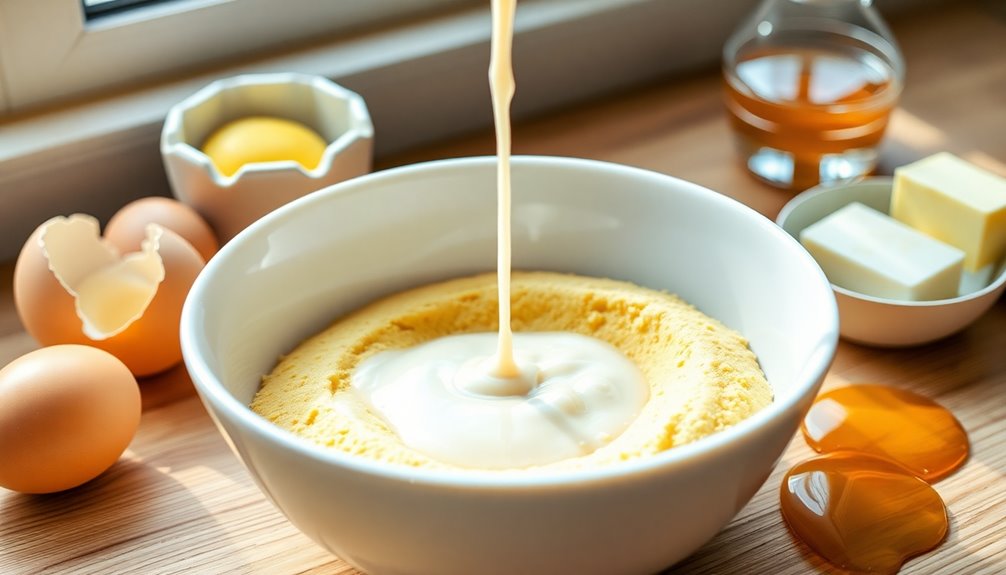
While the ingredients you choose are important, the cooking techniques you use can make a significant difference in achieving fluffy pancakes. Start by preheating your griddle to 375°F, and test it with a small pancake. Mixing your dry and wet ingredients separately to avoid overmixing is crucial, as it helps preserve the delicate egg structure that contributes to fluffiness, and let the batter rest for 5 to 15 minutes. Resting the batter allows gluten to relax, enhancing fluffiness. When you pour the batter, watch for bubbles forming around the edges before flipping.
| Technique | Tip |
|---|---|
| Preheating | Use 375°F for ideal cooking |
| Mixing | Keep dry and wet ingredients separate |
| Pouring | Look for edge bubbles before flipping |
| Maintaining Heat | Reapply oil between pancakes |
Following these steps guarantees you'll enjoy perfectly fluffy pancakes!
Serving Suggestions
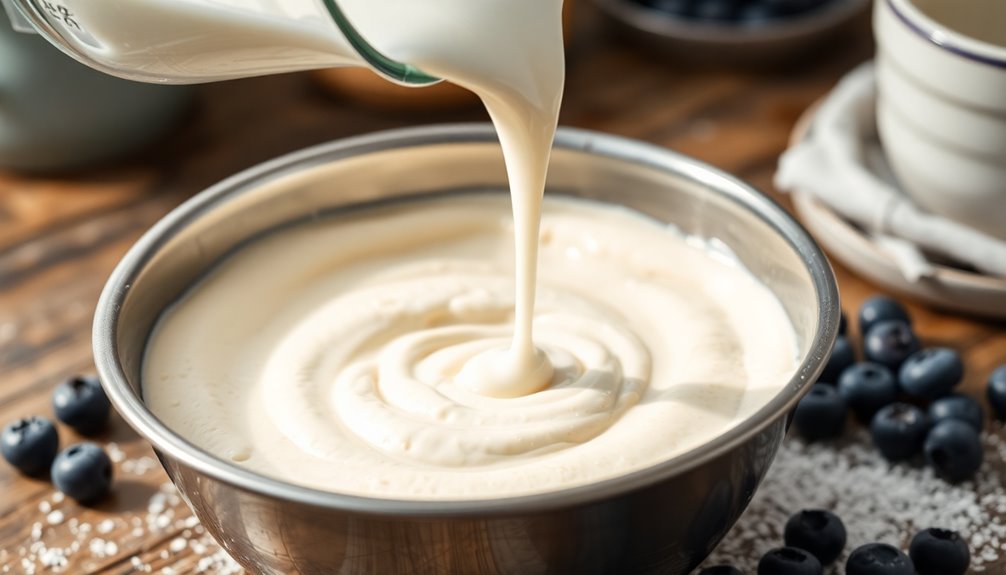
When it comes to serving pancakes, the right toppings can elevate your meal from ordinary to extraordinary. Here are some fantastic serving suggestions to take into account:
- Traditional Toppings: Think butter and maple syrup, fresh berries, or a dollop of whipped cream for that classic touch. Adding a sprinkle of colorful sprinkles can also bring a festive flair to your pancakes.
- Savory Pairings: Try serving your pancakes with eggs, cheese, or even crispy bacon for a hearty breakfast; this works particularly well with fluffy pancakes that have been made with the right mixing techniques.
- Creative Combinations: Get adventurous with chocolate chips, Nutella, or a drizzle of caramel sauce for a sweet twist.
No matter how you choose to top your pancakes, these suggestions will enhance your fluffy creations, making breakfast a delightful experience every time!
Frequently Asked Questions
Can I Use Water Instead of Milk for Pancakes?
Yes, you can use water instead of milk for pancakes, but it might change the flavor and texture. Your pancakes may taste less rich, so consider adding vanilla, butter, or spices to enhance the flavor.
Keep in mind that using water can make the batter thinner, so you might need to adjust the consistency by adding flour. Letting the batter rest will help, too, ensuring your pancakes turn out light and fluffy.
How Can I Make Pancakes Healthier?
To make pancakes healthier, you can start by using whole wheat flour for added fiber.
Swap out butter for coconut oil and consider adding mashed bananas or applesauce to cut down on sugar.
You might also try incorporating Greek yogurt or protein powder for a protein boost.
Using natural sweeteners like honey instead of refined sugar can enhance flavor while keeping it nutritious.
Don't forget to add spices for extra taste without extra calories!
Can I Freeze Leftover Pancakes?
Yes, you can freeze leftover pancakes!
First, let them cool completely on a rack to avoid sticking.
Then, place them in a single layer on a baking sheet lined with parchment paper and freeze for about an hour.
Once firm, transfer them to an airtight container or resealable bag, removing as much air as possible.
Label the bag with the date, and they'll stay fresh for up to three months!
What Toppings Pair Well With Pancakes?
When you're looking for toppings that pair well with pancakes, you've got plenty of delicious options.
For sweet cravings, try chocolate-filled pancakes with caramelised bananas or classic blueberry pancakes topped with syrup.
If you're in the mood for something savory, consider smoked salmon with a poached egg.
Don't forget fresh fruits like strawberries or sautéed apples to add a vibrant touch.
Experiment and find your perfect pancake topping combination!
How Can I Store Pancake Batter?
Ever wondered how to keep your pancake batter fresh for those spontaneous breakfast cravings?
You can store pancake batter in the fridge for up to 2-3 days in an airtight container. Just remember to label it with the date!
If you want to save it longer, freeze it in airtight bags for up to 3 months.
Always check for spoilage before use—off odors or unusual colors are signs it's time to toss it.
Conclusion
By incorporating milk into your pancake mix, you elevate your breakfast from mundane to magnificent. Remember to choose the right type of milk and mix it with care to achieve that fluffy texture. Don’t overlook the importance of leavening agents and fat content, as they play an essential role in the overall outcome. So, as you prepare your delightful stacks, channel your inner culinary maestro and savor the results that even a Renaissance court would envy! You can also enhance your pancake experience by experimenting with different toppings, such as fresh fruit, maple syrup, or even a dollop of whipped cream to add a touch of indulgence. For those planning a gathering, such as a women’s retreat activity suggestions could include a pancake-making workshop, where participants can share their favorite recipes and toppings, fostering creativity and camaraderie. As you whip up these delightful stacks together, you’ll not only nourish your bodies but also build lasting memories that will warm your hearts.
